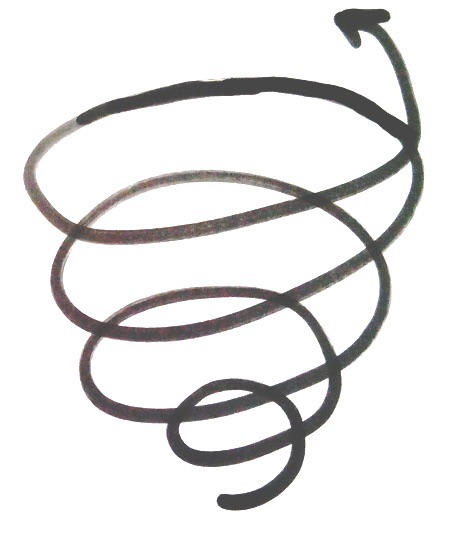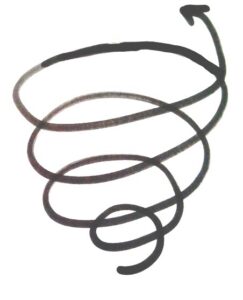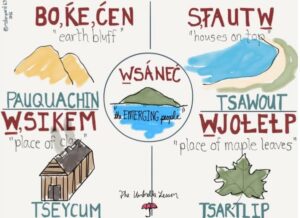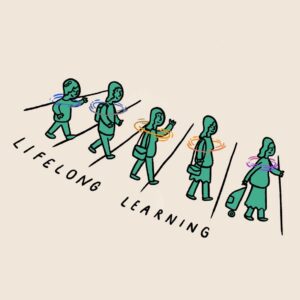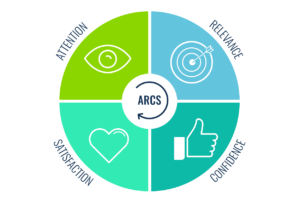Starting with the End in Mind
Through my teaching, I have realized that when I clearly envision what students should understand or be able to do by the end of a lesson, it transforms the way I approach teaching. Wiggins and McTighe’s concept of backward design resonates strongly here: starting with the desired outcomes allows me to work backwards in structuring meaningful activities.
When I planned a grade 4 diorama project last spring on natural environments, I began by imagining what a successful final product would look like and how students could demonstrate their understanding of ecosystems. This clarity gave direction to the entire project. I was able to scaffold activities that gradually built knowledge of habitats and ecological interactions, while still leaving space for students’ creativity and personal expression. Students experimented with materials, made choices about which natural elements to include, and reflected on how their dioramas represented ecosystems. The process reinforced for me how powerful it is to start with the “why” of learning, helping students find purpose in their work and making lessons both engaging and meaningful.
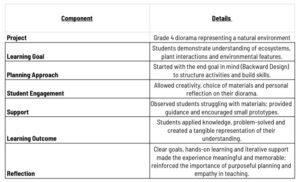
Table of the grade 4 diorama project (why it connects)
Empathy, Iteration, and the Spiral of Learning
Another insight I gained was the role of empathy and iteration in learning design. Kolb’s experiential learning cycle emphasizes that knowledge is created through a process of experience, reflection, and adjustment, which I’ve seen in action with my students. Some initially struggled with selecting materials or identifying ecological characteristics of their chosen environments. By observing closely, asking guiding questions, and encouraging them to create small prototypes, I could see where support was needed and adjust my approach accordingly.
This iterative process reminded me of the spiral model of learning. Unlike a flat line or simple repetition, the spiral emphasizes moving deeper with each iteration, connecting prior knowledge to new applications. Each time students revised their diorama, they weren’t just repeating tasks, they were layering new insights onto their earlier understanding. This spiral of reflection and refinement created a safe, low-stakes environment for problem-solving, where students felt supported but not constrained. It reminded me that learning is rarely linear, it involves trial and error, reflection and growth.
Surface vs. Deep Learning
Reflecting on my own learning experiences also underscored the difference between surface-level and deep learning. In one math unit, I memorized formulas for area, perimeter and volume, which allowed me to perform well in the short term but left me without lasting understanding. In contrast, a project where I had to design a classroom layout and calculate space needs required me to apply mathematical concepts in a real-world context.
This connects directly to Wright’s TEDx Talk, where she emphasizes that early experiences and active engagement shape lifelong learning. When I worked on the classroom design, I wasn’t just memorizing formulas, I was actively exploring and problem-solving, much like the meaningful, hands-on experiences Wright describes. Both examples highlight that learning is most impactful when it is relevant, engaging and allows learners to construct knowledge themselves rather than passively absorb information.
Designing for Relevance and Inclusion
This also connects to my teaching philosophy: I want students not only to acquire knowledge but to see how they can use it to make sense of and positively impact the world around them. Universal Design for Learning (UDL) reminds me to plan with flexibility in mind so that every student can access and engage with the content in meaningful ways.
When lessons are designed with clear outcomes, authentic contexts, opportunities for iteration and a spiral approach that deepens understanding over time, they become more than just tasks, they become experiences. These experiences foster curiosity, ownership and deeper connections between classroom learning and everyday life.
Moving Forward
Overall, this module reinforced that intentional planning, empathy, iteration and relevance are central to designing meaningful learning. Designing experiences that are student-centered, hands-on and aligned with clear outcomes allows students to engage deeply, take ownership of their learning, and connect classroom concepts to real-world applications. Like the spiral, my teaching will continue to build on prior experiences, moving deeper with each iteration to create lessons that are purposeful and memorable.
References:
Visser, C. (2020, September 1). Ending downward spirals by replacing them with upward spirals. Progress-focused. https://www.progressfocused.com/2015/04/ending-downward-spirals-by-replacing.html
TED. (2021, August 9). How Every Child Can thrive by Five | Molly Wright | TED. YouTube. https://www.youtube.com/watch?v=aISXCw0Pi94
